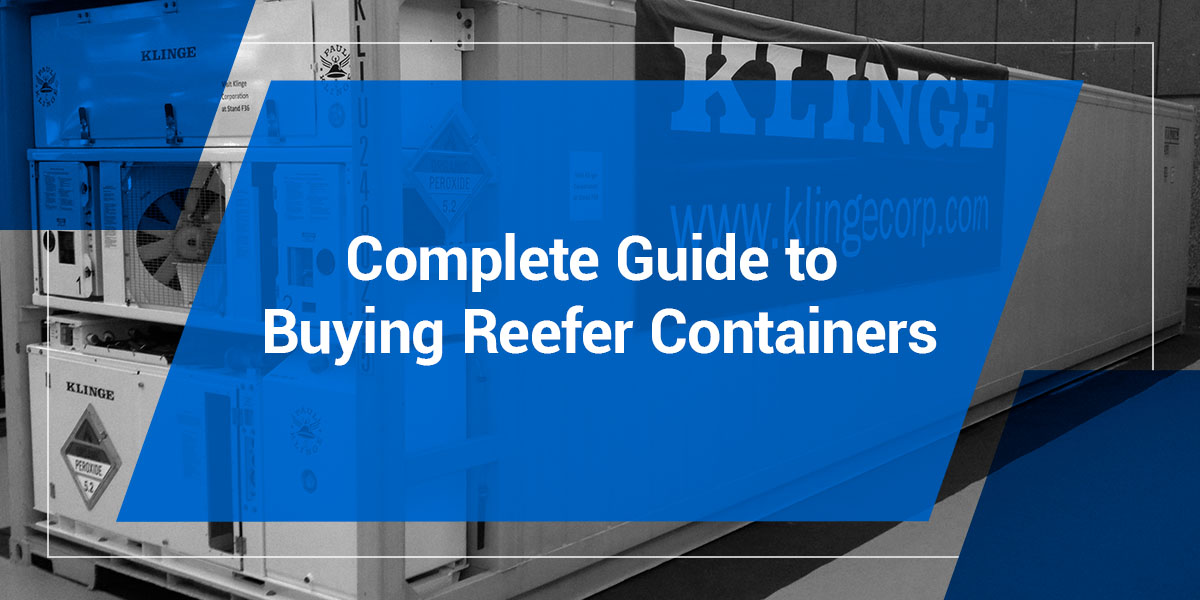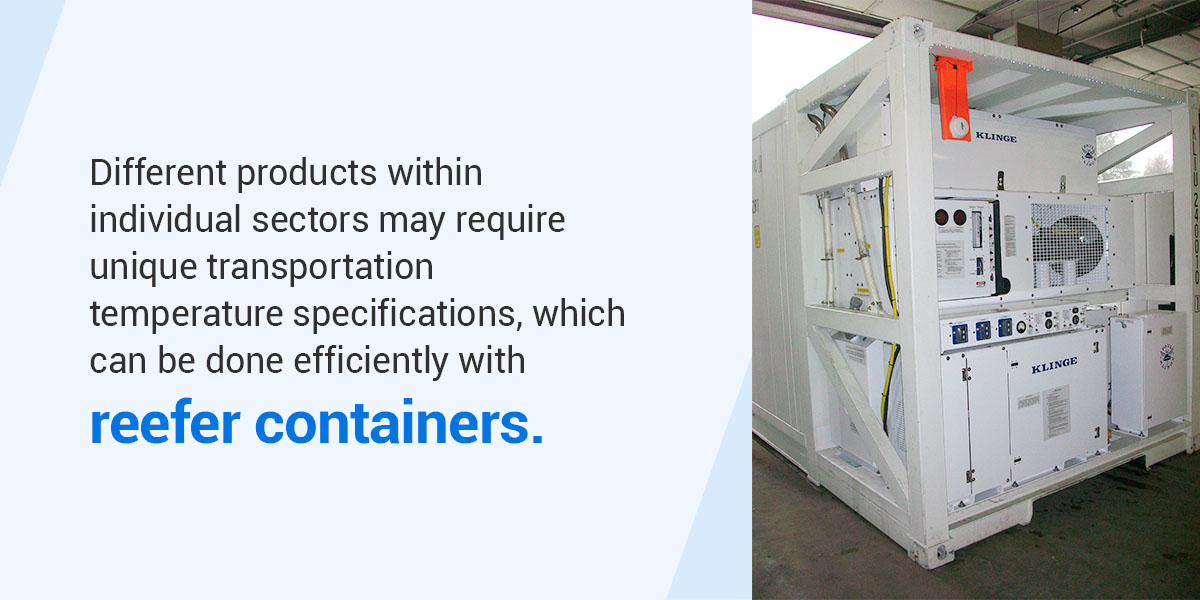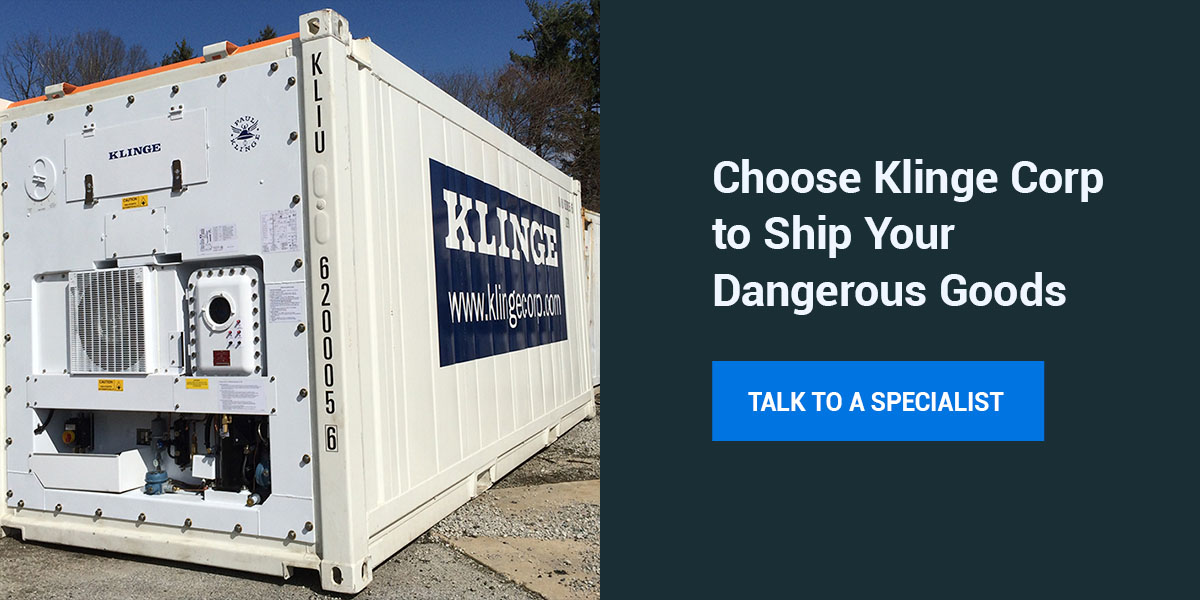Logistics is the backbone of every organization, and reefer containers play an essential role in transportation. However, some business owners lack the information to help them purchase a suitable reefer container for their businesses. As a result, they may end up getting low-quality products that do not meet their daily needs.
Before buying a reefer container, it is important to assess how it will help your business. You also need to know the types and sizes of reefers available on the market and the steps you should take to purchase one. This guide will assist you in securing the best reefer containers available today.
Table of Contents
- Reefer Containers: What They Are
- How Reefer Refrigeration Works
- Common Uses for Reefer Containers
- Top Benefits of Reefer Containers
- Available Sizes & Types
- How to Buy a Reefer Container
- FAQs About Reefer Containers
- Why Choose Klinge?
What Is a Reefer Container Refrigeration System?
Reefer containers are specialized containers for shipping temperature-sensitive cargo. They are fitted with cooling units to maintain the load under stable temperatures and, if necessary, humidity levels throughout the journey. These shipping systems protect the products from spoiling or experiencing temperature excursions due to exposure to heat, moisture, insufficient airflow or extreme drops in temperature.
How Does a Reefer Container Refrigeration System Work?
A refrigeration system supplies air temperatures from one end of the reefer container to the other end of the container, either through the “T-Floor” under the product and/or product pallets in the case of a bottom-air delivery system (the most common type) or over the product in a top-air delivery system.
The primary air supply is directed from the refrigeration unit to the container doors. When the refrigeration unit delivers supply air, the air is pushed toward the container doors, and eventually cycles back to the cooling unit, creating a continuous cycle and exchange of cold air.
Applications of Reefer Container Refrigeration System
Reefers have broad industrial applications, including the following:
- Pharmaceutical and medicine: Approximately $260 billion of annual bio-pharma sales depend on cold chain logistics to flourish. As a result, reefer containers are crucial in the pharmaceutical and medical industries. Manufacturers and distributors utilize reefers in order to move products with little or no damage.
- Seafood and meat processing: The annual global losses in the food industry are more than $750 billion, primarily due to improper food safety handling procedures, lack of proper facilities and insufficient training of personnel engaged in the cold chain. Seafood and meats are some of the most delicate food products on the market — they require proper attention and monitoring. Reefer containers help shippers in the food processing industry maintain the correct food temperatures throughout transportation, which is vital to the sector’s success. Klinge also produces specialized thawing systems for stationary on-site beef, pork, and poultry processing.
- Chemical and petrochemical: Chemical transportation requires excellent care and awareness to ensure optimum safety. For instance, an exothermic reaction can occur if the temperatures of chemicals such as self-reactive substances and organic peroxide are incorrectly maintained. Therefore, these products must travel via reefers.
- Military, government and aid organizations: Transportation of food and medicine must satisfy strict defense standards. Temperature-controlled military containers allow you to store and safely transport ready-to-eat meals supplies across various destinations. Reefers can also be designed and customized with precise temperature specifications for special missions.
- Offshore oil and gas: The oil and gas industry is one of the most regulated industries in the world. One such regulation is the ATEX Directive 2014/34/EU, a widely accepted standard for equipment used in explosive atmospheres, where the reefer systems are designed to prevent possible ignition of explosive gases.
Benefits of Buying Reefer Container Refrigeration Units
Reefer containers are integral to the transportation of products in various industries. Organizations worldwide invest in refrigerated containers for the following reasons:
1. Reefer Containers Work in a Number of Different Applications
Almost every sector has strict regulatory protocols and standards for shipping products. Businesses worldwide need to protect their cargo when transporting them. That is what makes reefer containers an absolute necessity.
A refrigeration system allows shippers from many industries to transport delicate cargo with minimal concern. Also, different products within individual sectors may require unique transportation temperatures or other specifications, which can be done efficiently with reefer containers.
With reefer containers, you can maintain a stable temperature throughout the transportation process regardless of your industry.
2. Come in a Wide Range of Types and Sizes
Products across industries have different characteristics and will require various storage and transport specifications. For example, while transporting dangerous goods may require explosion-proof or redundant refrigerated containers, meat or seafood transportation requires freezer and sometimes deep freezer systems.
Additionally, organizations may require special container sizes for various reasons. Besides the standard sizes and features, reefers are customizable according to your particular needs. This customizability makes them suitable for ocean, road or rail transportation. Many businesses take advantage of these features to scale up their operations.
3. Lead to Cost Savings
Businesses can lose tremendous amounts of money due to poor transportation procedures and a lack of storage facilities. Reefer containers allow you to safely transport different products at the recommended temperatures, reducing the risk of losing valuables. Reefer manufacturers employ state-of-the-art technology to create the best solutions you can personalize according to your budget and needs. Further to this trend, Klinge also offers dual redundant systems to provide back-up in case of any failures which may occur and track and trace device to provide notifications remotely via GSM and/or Satellite connections.
4. Provide Durability
Reefers are designed and built by experienced engineers with tools and techniques that allow them to meet the strict durability requirements needed to keep products safe and secure. Reefer materials are also robust and can withstand strong winds, intense water currents and other harsh climatic conditions.
5. Offer Diverse Transportation Options
A significant advantage of reefer containers is the ability to use them on multiple carriers, making them suitable for inland and oversea transports. Refrigerated containers offer various alternatives depending on your business’s needs and the budget allocated for transportation.
What Sizes and Types of Reefer Containers Can You Buy?
There are different types and sizes of reefers available. Here is what to know when buying refrigerated containers for ocean transport or stationary storage:
Different Container Sizes
Shipping companies and manufacturers calculate rates according to the twenty-foot-equivalent-unit (TEU) and the forty-foot-equivalent-unit (FEU).
TEU is the size of a standard 20-foot shipping container, 20 feet in length, 8 feet in width and 8 feet 6 inches in height. These 20′ containers weigh approximately 3,080 kg (6,791 lbs.) and with a max gross weight of 30,480 kg (67,200 lbs.) can carry a payload weighing approximately 27,400 kg (60,417 lbs) and can hold nine to 10 pallets, depending on whether they are standard American or European. The typical American pallet measures 40 inches (1016mm) by 48 inches (1219mm), while the European standard is 1200mm (47.2 inches) x 800mm (31.5 inches).
The FEU is the size of a standard 40-foot standing container, with internal dimensions of approximately 40 feet in length, 8 feet in width and 9 feet 6 inches in height. These containers weigh approximately 4,800 kg (10,584 lbs.) and with a max gross weight of 34,000 kg (74,960 lbs.) you can load to a maximum overall weight of 29,520 kg (65,080 lbs.). A 40-foot container can hold 22 to 23 pallets, again depending on whether they are standard American or European sizes.
Main Types of Refrigerated Containers
The three main types of reefer containers are:
- Standard reefers: These are the most common reefer types on the market. Standard reefers have integrated cooling systems with heating capabilities, which makes them suitable for all sea-based containers that meet ISO standards.
- Controlled atmosphere reefers: These reefers stand out due to their ability to monitor and adjust certain gas levels in the container (such as CO2 and oxygen) in order to keep perishable products fresher longer.
Refrigeration Containers for Sea and ISO Standards
Examples of high-quality refrigeration unit products for ISO containers and sea containers are:
-
- Standard refrigerated containers: These types of reefer containers include single refrigeration units for ISO containers. They are suitable for wide applications, such as shipment of frozen meat, fresh produce, and lower-value pharmaceuticals. You can select the 20-foot or 40-foot refrigerated container depending on your specifications, but the 40-foot versions are by far the most common.
- Dual refrigeration containers: These units have two full-capacity reefer units – each capable of maintaining the required product temperature – and can include an option for a built-in generator set and spare parts kit. You can use dual reefer containers for storing and transporting temperature-sensitive products, including high-value pharmaceuticals and dangerous goods such as chemicals. They are available in either 20-foot or 40-foot ISO container models.
- Refrigerated tank containers: Temperature control units for tank containers circulate glycol, brine or synthetic oil around the external coils to cool and heat the tanks, typically sized around 24,000 liters (6,340 gallons). This feature makes them suitable for bulk beverages, pharmaceuticals and hazardous and non-hazardous chemicals.
- Explosion-proof refrigerated containers: The refrigeration units for these containers are designed for explosive gas atmospheres and harsh conditions, making them suitable for the oil and gas industry. Klinge’s explosion-proof registered containers are designed to meet the European Union’s (EU) ATEX Directives and can safely operate in Hazardous Zone 1 and 2 areas.
- Ultra-Low Temperature Containers: Ultra-Low Temperature (or “ULT”) containers are designed for internal cargo temperatures below -40°C (-40°F) and down to -70°C (-94°F). They are ultra-insulated to prevent heat ingress, include customized structural designs, and also utilize special materials for the low temperatures. The ULT Freezer units themselves also normally include a vacuum valve due to the large temperature differences inside and outside of the container. Klinge’s versions also allow for dual-redundant ULT systems with an optional integral generator set and spare parts kit.
- Military refrigerated containers: As the name suggests, military refrigerated containers are built for several military tests, including Category A1 and B2 cooling. Depending on the module specifications, they are normally available in both 10-foot or 20-foot container versions, and sometime in even smaller versions.
- Offshore DNV containers: Offshore DNV containers are built for the rough offshore environment including high salt atmosphere and sling-lifting onto oil rigs or Floating Production Storage and Offloading (FPSO) vessels. When fitted with explosion-proofer refrigeration units, they are also conducive to the explosive atmosphere encountered on oil tankers, FPSOs, and rigs. Again, offshore containers are certified to meet the DNV 2.7.1/EN12079 requirements for enhanced safety.
What Is the Buying Process for a Refrigerated Container?
The following steps should guide you when buying a reefer container:
1. Evaluate Your Needs
When buying a container, assess your business needs and the challenge you want to solve with the reefer. This consideration helps you know which type or size of reefer to purchase and whether to choose the standard alternatives or build a custom unit. While there are industry standards you may need to follow, learning more about the specific products you deal with is essential to make the correct decision, too.
2. Consider Your Budget
The prices of reefers depend on factors such as the dimensions, functions and the location of purchase. After evaluating your business needs, make a list of the required functions and request a quote from a manufacturer. It also helps to seek professional advice to be sure the budget available can build the refrigerated container you need for that particular job. Also keep in mind that if you do spend more on a system with great capabilities such as dual-redundancy or integral power, you may ultimately save more in the long run by avoiding product loss and temperature excursions.
3. Assess the Specifications
Consider the product temperature range, container size, power requirements and other special features like sensors and trackers to keep your products safe. The reefer container you purchase should accommodate the number of products you regularly transport and protect them throughout the journey.
4. Locate a Trusted Supplier
Locating a reliable manufacturer is crucial. Conduct thorough research online, consult experts in the field and ask colleagues to identify who can deliver quality products that meet your business’s needs and increase your return on investment. It is important also that you understand how spare parts and service for the equipment will be provided around the globe as some manufacturers only have regional support for their equipment. If you are buying through a reseller, make sure that the equipment being ordered will be able to be supported for many years into the future.
5. Contact the Seller and Make the Purchase
Contact your chosen supplier and inquire about the type of reefer you need. Ask questions about the unique specifications and features you can add for optimum performance and arrange the contract. Finally, make arrangements for delivery, logistics and installation.
Frequently Asked Questions
Do you have further questions about reefer containers? Read some FAQs here:
1. Should You Buy or Rent a Reefer Container?
Buying reefers is preferable to many organizations, as the assets are owned and can be called on any time, thereby making logistics more manageable and enhancing the flow of business operations. Planning logistics has become more challenging the ever, and purchasing refrigerated containers helps you avoid the increase in rent cost and inconvenience which can occur, particularly in certain high-utilization seasons.
Buying reefer containers instead of renting may be ideal in allowing you to run a complete business and perform better against competitors. But if your need is short-term and capital expenditure approvals are difficult in your organization, adding the rental cost of a reefer as an expense may be the preferable way to go.
2. How Do Delivery and Logistics Work When Purchasing Reefers?
After purchasing reefers, you may arrange with the vendor to transport the unit to your desired location. You can also negotiate with a third party to assist with transportation and installation. However, securing a professional with experience in reefer delivery and logistics is best. It also helps if the manufacturer offers complete services, including repairs.
The contract may state when the risk of loss and title will transfer to the buyer. This is important because it gives you an idea of who to hold liable should any challenges arise from the delivery to the installation stage.
3. Do You Need a CSC Certificate?
Yes, your shipping container must be CSC-approved. This certification is to ensure optimum safety during the shipping process and facilitate the international transportation of containers by providing uniform safety regulations.
Choose Klinge Corporation for Premium Reefer Containers
Logistics is integral to your business’s success, which makes reefer containers an absolute necessity when you handle products with short shelf lives or special transportation requirements. Organizations in various industries rely on refrigerated containers when transporting valuable products, whether by sea, road or rail.
Klinge Corporation is a global leader in designing and manufacturing specialized transportation refrigeration units. We partner with customers worldwide to offer personalized services and products that help them do what they do best. Contact us today to learn more — we are ready to help you grow your business.




